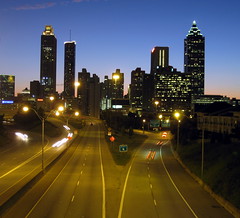You are probably aware of the substantial energy a commercial office building requires for comfort heating and cooling, ventilation, water heating, lighting, miscellaneous equipment, and elevators. These energy systems are visible because they are metered by utilities and paid for by building owners and tenants. But utility-metered energy consumption is typically a fraction of the total building energy impact. Transportation activity is a major component of what I and others refer to as “whole-building” energy consumption.
A Framework for Estimating Transportation Energy Use
In an NSF-sponsored research project, I developed a framework for estimating the potential energy performance of building and site alternatives for commercial office space. Applying my framework to 25,000 SF, 100-employee office spaces in the Atlanta, GA metropolitan area, I found that transportation energy consumption for employees driving to work can be 5 – 6 times higher than metered building energy consumption. If we consider the consumption of “primary” energy in the building utility energy supply chains (primary energy includes energy used to generate and transport the energy consumed in the building along with the building energy consumption), then transportation energy consumption for employees driving to work is typically twice the primary energy use attributed to the building operation.
The relative proportion of transportation to building energy consumption for commercial buildings depends upon many factors, such as building energy efficiency, occupant schedules and demographics, climate zones, land use (i.e., jobs/housing balance and density) and available modes of transportation. Nevertheless, transportation energy efficiency represents a major opportunity for reducing the whole-building energy consumption of commercial buildings.
Opportunities for Improving Transportation Energy Efficiency
Building owners and tenants can improve the transportation energy efficiency of their buildings through a variety of design and operational strategies:
- Selecting a site that minimizes travel distance from/to commute origins.
- Selecting a site that minimizes single occupant vehicle mode share.
- Implementing a travel demand management program, which may include alternative mode share incentives and alternative work week scheduling.
- Providing or accessing infrastructure that supports utilization of higher efficiency vehicles (e.g., electric vehicle charging stations).
The LEED rating system from the U.S. Green Building Council and most Smart Growth and Transition Towns (there are a number in Vermont) recognize the critical importance of siting to transportation efficiency. But most businesses do not build or select building sites very often, and my research confirmed that of many others interested in energy behavior change — simply choosing a location with public transportation access is not likely to minimize transportation energy consumption. Sustained behavior change requires multiple strategies and sustained support.
I was delighted to discover that here in Vermont, particularly in the Burlington area, we have a number of organizations working to improve transportation efficiency. I have listed a few resources below, and look forward to helping Vermont building owners and tenants achieve their whole-building energy performance goals, including transportation efficiency.
Resources



